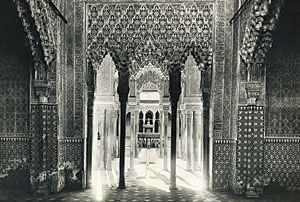There are a number of Campbell’s Laws of Architecture; they tend to take the form of paradoxes.
Campbell’s First Law, for example, states: “The faster the means of transportation in any society, the larger will be the portion of the average citizen’s life that is spent in getting from one place to another.”

Peasant’s walk to the fields? Twenty minutes. Commute from the suburbs? Fifty minutes. Plane to the coast? Six hours. Rocket to the moon? Four days. As the world becomes more accessible, we access it more, and we waste more time doing so.
Okay, here’s Campbell’s Second Law: “With every advance in technology, there is a corresponding loss of sensory experience.”
Again, we can take transportation as an example, although just about anything will do. You’re on a horse, your butt is sore, it’s raining, you’re sneezing from hay fever, a highwayman waits behind a tree — you’re experiencing the world with all your senses. Then technology advances and creates the railroad, where the world resembles a visual film strip, unspooling itself past the frames of the windows. At least you can still sense the lurch and whistle of the train. But then in an airplane, you’re confronted with an actual film, a further step removed from sensory experience. Finally, on the space ship, you don’t even have gravity.
This law works with writing, too. As I type this, I’m reminded that I miss the sociable clatter of keys and bells and the smell of the ribbon of my old typewriters. Would I go back? Of course not. But I’ve traded away experience in order to gain convenience. So often, that’s what technology accomplishes.
The particular Campbell’s Law I want to discuss today, though, is the Third. It runs as follows: “A society will create its most monumental buildings when the society and its culture are about to disappear. They will be the product of a last desperate effort to impede the forces of decay.”
My favorite example of this law has always been the Alhambra Palace in Granada, Spain, which may be my all-time favorite building. It was erected by the Moors just in time for the Spaniards to drive them out of the country. Banister Fletcher calls it “the last purely Muslim building in Spain.” I just looked it up and discovered that the Moors kept it longer than I thought, nearly 100 years. But throughout that time, the borders of Moorish Spain were shrinking until Granada and its palace had become a Muslim island in a Christian sea.
I thought I’d invented the Third Law for myself, but I find in this week’s New York Review of Books a quotation from the great American theologian Reinhold Neibuhr. It seems Neibuhr got there first. He wrote: “One of the most pathetic aspects of human history is that every civilization expresses itself most pretentiously, compounds its partial and universal values most convincingly, and claims immortality for its finite existence at the very moment when the decay that leads to death has already begun.” Yikes!
Should we worry? Are any aspects of our own culture claiming immortality through the creation of pretentious architectural tombstones?


Post a comment to this article
Report Abusive Comment